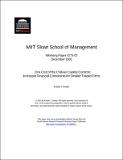| dc.description.abstract | There is growing support for taxes on short-term capital inflows in emerging markets,
such as the encaje adopted by Chile from 1991-98. Previous empirical assessments of
the encaje conclude that it may have generated some small economic benefits, such as
shifting the composition of capital inflows to a longer maturity, but no significant
economic costs. Managers of small and medium-sized companies in Chile, however,
claim that the encaje made it substantially more difficult to obtain financing for
productive investment. This paper assesses whether the Chilean capital controls
increased financial constraints for different-sized, publicly traded firms. It uses two
different testing methodologies: a Tobin's-q and Euler-equation framework. Results
indicate that during the encaje, smaller traded firms in Chile experienced significant
financial constraints and these constraints decreased as firm size increased. Both
before and after the encaje, however, no group of traded firms experienced significant
financial constraints, and there is no relationship between firm size and financial
constraints. Although Chilean-style capital controls may also have significant benefits,
this cost of the encaje could be particularly important in emerging markets where
smaller firms are valuable sources of job creation and economic growth | en |
